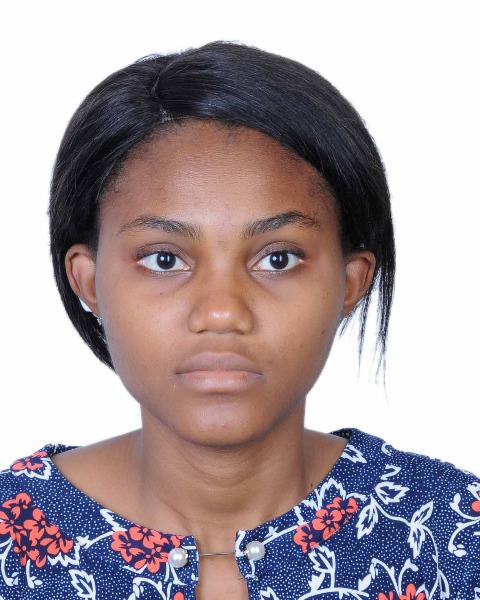Preclinical, Clinical, and Translational Sciences
(M1130-05-28) Clay Attenuates Diarrhea Induced by Fat in a Mouse Model

Shalom Emmanuel, MPH (she/her/hers)
student
Texas Southern University
Houston, Texas, United States
Shalom Emmanuel, MPH (she/her/hers)
student
Texas Southern University
Houston, Texas, United States- NS
Nyma Siddiqui, Ph.D.
student
Texas Southern University
Houston, Texas, United States - TD
Ting Du, Ph.D.
Research Scientist
Texas Southern University
Houston, Texas, United States - EA
Eric A. Asare, Pharm.D.
Graduate Research Assistant
Texas Southern University
Houston, Texas, United States 
Yuan Chen, Ph.D. (he/him/his)
Research Assistant Professor
Texas Southern University
Houston, Texas, United States- HX
Huan Xie, Ph.D.
Professor
Texas Southern University
Houston, Texas, United States - DL
Dong Liang, Ph.D.
Professor
Texas Southern University
Houston, Texas, United States 
Song Gao, PhD (he/him/his)
Associate Professor
Texas Southern University
Houston, Texas, United States
Presenting Author(s)
Main Author(s)
Co-Author(s)
Methods: GTO was administered to mice at different doses through oral gavage to induce diarrhea. Clay was treated through oral gavage to evaluate its anti-diarrhea effect. Fecal conditions were monitored. Intestinal tissues were subjected to histological examination to assess structural integrity. The total fecal bile acids were evaluated using a bile acid assay kit to determine the mechanism of action.
Results: The results showed that diarrhea incidence and severity increased with elevating concentrations of GTO (from 100 mg/kg, 200 mg/kg, 1000 mg/kg, to 2000 mg/kg). When the animals were treated with clay, diarrhea incidence and severity were decreased significantly in a dose-dependent manner. Compared to the untreated control group receiving Glyceryl trioleate (GTO) alone, co-administration of clay at 2000 mg/kg reduced diarrhea scores, resulting in a 48% reduction in diarrhea scores, while the higher dose of 4000 mg/kg clay achieved an 83% reduction. Fecal bile acid analysis showed that diarrhea is associated with total bile acid levels in the feces. Histological examination showed that diarrhea is associated with tissue inflammation in the colon.
Conclusion: This study demonstrated that GTO administration can induce diarrhea in mice, and clay can effectively alleviate fat-induced diarrhea, most likely through two primary mechanisms: adsorption of dietary fats and modulation of fecal bile acid composition. These findings suggest that this model can be used to evaluate diarrhea associated with excessive amounts of fat in the diet, and clay can be further tested for its potential to attenuate diarrhea.
References: 1. Duan Y, Zeng L, Zheng C, Song B, Li F, Kong X, Xu K. Inflammatory Links Between High Fat Diets and Diseases. Front Immunol. 2018;9:2649.
2. Owczarek D, Rodacki T, Domagala-Rodacka R, Cibor D, Mach T. Diet and nutritional factors in inflammatory bowel diseases. World J Gastroenterol. 2016;22(3):895-905.
Acknowledgements: This work was supported by National Institute of Health Grant number R16 GM149425 for Song Gao. This work was also made possible by services provided by the GCC Center for Comprehensive PK/PD and Formulation (CCPF) with CPRIT grant number RP240430 and the National Institute of Minority Health and Health Disparity with grant number U54MD007605 for Dong Liang and Huan Xie.
 Figure 1: The diarrhea score was evaluated during the five days of treatment. Diarrhea incidence rose dose-dependently at 0.2% at 100 mg/kg, 0.3% at 200 mg/kg, 0.5% at 1000 mg/kg, and 2.1 % at 2000 mg/kg of GTO. The results are expressed as mean ± SEM (n = 10).
Figure 1: The diarrhea score was evaluated during the five days of treatment. Diarrhea incidence rose dose-dependently at 0.2% at 100 mg/kg, 0.3% at 200 mg/kg, 0.5% at 1000 mg/kg, and 2.1 % at 2000 mg/kg of GTO. The results are expressed as mean ± SEM (n = 10).  Figure 2: The diarrhea score was evaluated during the five days of treatment. Compared to the control group receiving glyceryl trioleate (GTO) alone (2000 mg/kg), clay co-administration at 2000 mg/kg reduced diarrhea scores, while the higher dose of clay co-administration at 4000 mg/kg achieved a significant diarrhea attenuation. The results are expressed as mean ± SEM (n = 10).
Figure 2: The diarrhea score was evaluated during the five days of treatment. Compared to the control group receiving glyceryl trioleate (GTO) alone (2000 mg/kg), clay co-administration at 2000 mg/kg reduced diarrhea scores, while the higher dose of clay co-administration at 4000 mg/kg achieved a significant diarrhea attenuation. The results are expressed as mean ± SEM (n = 10). Figure 3: Colon tissue histological exam. Histological sections were stained with HE and observed under a microscope for tissue damage. The control group was treated with vehicle only, the untreated group was administered GTO (2000 mg/kg/day, p.o.); the MMT-treated group was co-treated with GTO (2000 mg/kg/day, p.o.) + MMT (4000mg/kg/day, p.o.). The control group showed normal villi, crypts, and a muscular layer. The untreated group showed inflammatory cell infiltration (ICI), loss of normal crypt architecture (LCA), and oedema (ED). The MMT-treated group showed restored architecture and reversed the effect of clay damage. Histological score results are expressed as mean ± SEM (n=5). *p < 0.05 (t-test).
Figure 3: Colon tissue histological exam. Histological sections were stained with HE and observed under a microscope for tissue damage. The control group was treated with vehicle only, the untreated group was administered GTO (2000 mg/kg/day, p.o.); the MMT-treated group was co-treated with GTO (2000 mg/kg/day, p.o.) + MMT (4000mg/kg/day, p.o.). The control group showed normal villi, crypts, and a muscular layer. The untreated group showed inflammatory cell infiltration (ICI), loss of normal crypt architecture (LCA), and oedema (ED). The MMT-treated group showed restored architecture and reversed the effect of clay damage. Histological score results are expressed as mean ± SEM (n=5). *p < 0.05 (t-test).